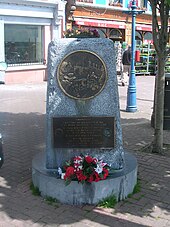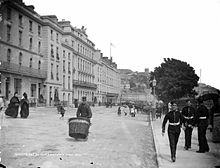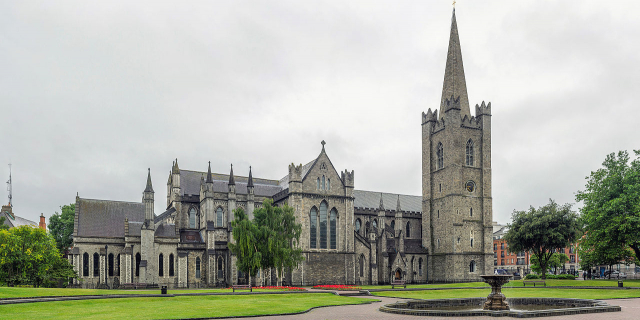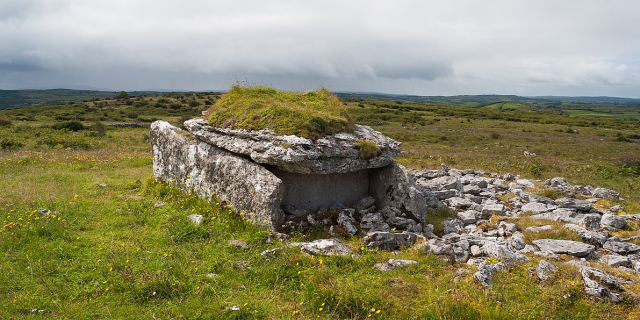Cobh
Cobh ( KOHV, Irish: An Cóbh), known from 1849 until 1920 as Queenstown, is a seaport town on the south coast of County Cork, Ireland. With a population of 14,418 inhabitants at the 2022 census, Cobh is on the south side of Great Island in Cork Harbour and home to Ireland's only dedicated cruise terminal. Tourism in the area draws on the maritime and emigration legacy of the town.
Facing the town are Spike and Haulbowline islands. On a high point in the town stands St Colman's, the cathedral church of the Roman Catholic Diocese of Cloyne. It is one of the tallest buildings in Ireland, standing at 91.4 metres (300 ft).
 Statue on the waterfront of Annie Moore and her brothers. Annie Moore was the first person to be admitted to the United States of America through the new immigration centre at Ellis Island, New York on 1 January 1892.Early history
Statue on the waterfront of Annie Moore and her brothers. Annie Moore was the first person to be admitted to the United States of America through the new immigration centre at Ellis Island, New York on 1 January 1892.Early history
According to legend, one of the first colonists of Ireland was Neimheidh, who landed in Cork Harbour over 1,000 years BC.[1] He and his followers were said to have been wiped out in a plague, but the Great Island was known in Irish as Oilean Ard Neimheadh because of its association with him. Later it became known as Crich Liathain because of the powerful Uí Liatháin kingdom, who ruled in the area from Late Antiquity into the early 13th century. The island subsequently became known as Oilean Mor An Barra (the Great Island of Barry & Barrymore), after the Barry family who inherited it.
 St. Colman's Cathedral
St. Colman's CathedralThe village on the island was known in English as Ballyvoloon, overlooking "The Cove". In 1743 the British built a fort, later to become known as Cove Fort, to the east of the village.[2] The settlement was first referred to as Cove village in 1750 by Smith the historian who said: "it was inhabited by seamen and revenue officials". The Cork directory of 1787 shows about thirty businesses in the town, including one butcher and one draper.
The Water Club established at Haulbowline in 1720 was the progenitor of the present Royal Cork Yacht Club (RCYC, now based in Crosshaven) and is the oldest yacht club in the world. The RCYC was based for many years in Cobh and the present Sirius Arts Centre used to be a clubhouse of the RCYC organisation. In 1966, the RCYC merged with the Royal Munster Yacht Club, retaining the name of the RCYC but moving its headquarters to those of the RMYC at Crosshaven at the other side of the harbour.
 The tower of St. Colman's Cathedral from the streets below19th century
The tower of St. Colman's Cathedral from the streets below19th century
International upheaval led to Cobh undergoing rapid development in the early 19th century. Due to the natural protection of its harbour setting, the town became important as a tactical centre for naval military base purposes, never more so than at the time of the Napoleonic Wars. Today, the Irish Naval Service headquarters is on Haulbowline Island facing Cobh.
The wars against the French led to the town, then usually known as Ballyvoloon or The Cove of Cork, being developed as a British naval port assigned an admiral. Many of the present-day buildings date from this time of build-up. George Brodrick, 5th Viscount Midleton engaged the English architect Decimus Burton to improve the streetscape and buildings during the 1840s.[3][4] The eventual cessation of hostilities dented Cobh's prosperity for a while, but it soon became known as a health resort; many patients stayed here for their health because of the temperate climate. Amongst their number was Charles Wolfe, who wrote "The Burial of Sir John Moore After Corunna". Wolfe's body is buried in the Old Church Cemetery outside the town.
The Titanic Titanic Memorial, Westbourne Place, Cobh
Titanic Memorial, Westbourne Place, CobhOne of the major transatlantic Irish ports, the town was the departure point for 2.5 million of the 6 million Irish people who emigrated to North America between 1848 and 1950. On 11 April 1912, as Queenstown, it was the final port of call for the Titanic before she set out across the Atlantic on the last leg of her maiden voyage. She was assisted by the P.S. America and the P.S. Ireland, two ageing White Star Line tenders, along with several other smaller boats delivering first-class passengers' luggage. Some sources and local lore suggest that a Titanic crew member, John Coffey, a native of Cobh, left the ship at this time, thereby saving his life.[5] 123 passengers boarded at Cobh, with only 44 surviving the sinking.
Penal transportationCobh was earlier a major embarkation port for men, women and children who were deported to penal colonies such as Australia. The Scots Church has since 1973 housed the Cobh Museum which holds records of such deportations in ships' log books. The Scots Church (a Presbyterian church until its 1969 closure) overlooks the harbour from where so many departed.
ShipbuildingA significant shipbuilding industry was developed in the town. The remnants of the Verolme Shipyard today maintain many of the original cranes and hoists now forming part of industrial and maritime heritage.
 The original pier (as it appeared in 2007) where passengers boarded tenders to the Titanic at its anchorage near the mouth of the harbour. The corner of the office building of the White Star Line can be seen on the right. The building today houses a Titanic museum.
The original pier (as it appeared in 2007) where passengers boarded tenders to the Titanic at its anchorage near the mouth of the harbour. The corner of the office building of the White Star Line can be seen on the right. The building today houses a Titanic museum.The age of steam brought Cobh association with several milestones, including the first steam ship to sail from Ireland to England (1821) and the first steamship to cross the Atlantic (Sirius 1838), which sailed from Passage West.
RMS Lusitania and the First World WarAnother ship to be associated with the town, the Cunard passenger liner RMS Lusitania, was sunk by a German U-boat off the Old Head of Kinsale while en route from the US to Liverpool on 7 May 1915. 1,198 passengers died, while 700 were rescued. The survivors and the dead alike were brought to Queenstown, and the bodies of over 100 who perished in the disaster lie buried in the Old Church Cemetery just north of the town. The Lusitania Peace Memorial is located in Casement Square, in front of the Arch Building housing the Cobh Library and Tourist Information Centre.[6]
 Cobh, then Queenstown, c. 1890s
Cobh, then Queenstown, c. 1890s The Arch Building (background) and the Lusitania Memorial (foreground)
The Arch Building (background) and the Lusitania Memorial (foreground)During the First World War, Queenstown was a naval base for British and American destroyers operating against the U-boats that preyed upon Allied merchant shipping. Q-ships (heavily armed merchant ships with concealed weaponry, designed to lure submarines into making surface attacks) were called Q-ships precisely because many were, in fact, fitted out in Queenstown.[7] The first division of American destroyers arrived in May 1917, and the sailors who served on those vessels were the first American servicemen to see combat duty in the war. When that first convoy arrived in port after enduring a rough passage in what were little more than open boats, its members were met by a crowd of sailors and townspeople, thankful for their anticipated help towards stopping the U-boats that were blockading western Europe. Admiral Sir Lewis Bayly, commander of the Coast of Ireland station, met the senior American officer, Commander Joseph Taussig, at the dock and inquired as to how soon the weatherbeaten American ships could be put to use. "We're ready now, sir!" was the widely quoted answer from the American.
The United States Navy established U.S. Naval Air Station Queenstown in February 1918. It operated flying boats during the last months of WW1, and closed in April 1919.[8]
Due to its tactical military importance, under the terms of the 1921 Anglo-Irish Treaty, the port remained a UK sovereign base within the Irish Free State after 1922. Along with the other Treaty Ports, it was handed over to the government of the Irish Free State in 1938.





























Add new comment